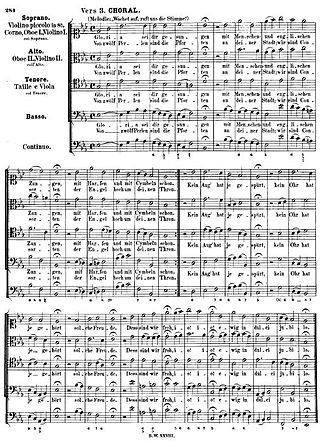
A Lutheran chorale is a musical setting of a Lutheran hymn, intended to be sung by a congregation in a German Protestant Church service. The typical four-part setting of a chorale, in which the sopranos sing the melody along with three lower voices, is known as a chorale harmonization.

Friedrich Spee was a German Jesuit priest, professor, and poet, most well known as a forceful opponent of witch trials and one who was an insider writing from the epicenter of the European witch-phobia. Spee argued strongly against the use of torture, and as an eyewitness he gathered a book full of details regarding its cruelty and unreliability. He wrote, "Torture has the power to create witches where none exist."

"For All the Saints" was written as a processional hymn by William Walsham How, who would later become the Bishop of Wakefield in the Church of England. The hymn was first printed in Hymns for Saints' Days, and Other Hymns, by Earl Nelson, 1864.

Marian hymns are Christian songs focused on Mary, mother of Jesus. They are used in both devotional and liturgical services, particularly by the Roman Catholic, Eastern Orthodox, Oriental Orthodox, Anglican, and Lutheran churches. They are often used in the month of May devotions. Some have also been adopted as Christmas hymns. Marian hymns are not popular among some Protestants, as they see Marian veneration as idolatry. However, the practice is very common among Christians of Catholic traditions, and a key component of the Eastern Orthodox liturgy. There are many more hymns to Mary within the Eastern Orthodox yearly cycle of liturgy than in Roman Catholic liturgy.
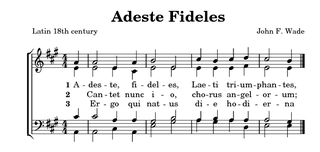
A hymn tune is the melody of a musical composition to which a hymn text is sung. Musically speaking, a hymn is generally understood to have four-part harmony, a fast harmonic rhythm, with or without refrain or chorus.
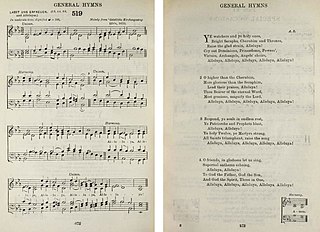
"Ye Watchers and Ye Holy Ones" is a popular Christian hymn with text by Athelstan Riley, first published in the English Hymnal (1906). It is sung to the German tune Lasst uns erfreuen (1623). Its uplifting melody and repeated "Alleluias" make this a favourite Anglo-Catholic hymn during the Easter season, the Feast of All Saints, and other times of great rejoicing.
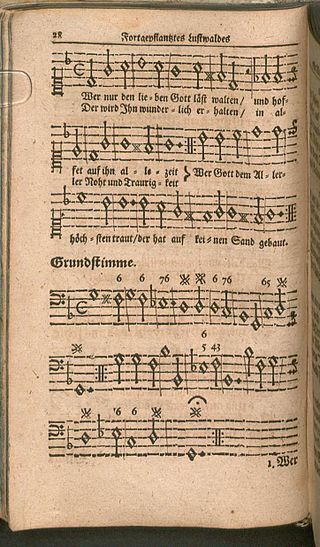
"Wer nur den lieben Gott läßt walten" is a 1641 hymn by Georg Neumark, who also composed the melody for it. It has seven verses and deals with the Christian putting their trust in God. Its author referred to it as a "Trostlied" or song of consolation and it first appeared in his Fortgepflantzer musikalisch-poetischer Lustwald. It also appeared in Johann Crüger's 1672 Praxis pietatis melica and in the first part of Johann Anastasius Freylinghausen's 1704 Geistreiches Gesangbuch. It has inspired musical settings, and is part of current German hymnals, both Protestant and Catholic.
David Gregor Corner, was a German Benedictine abbot, hymn writer and theologian best known for his influential 1631 Gross Catholisches Gesängbuch. Born in Hirschberg, Germany, he studied theology at Prague, Graz and Vienna, where he earned a doctorate. He became a pastor in Retz in 1614. In 1628 he became a novice monk at Göttweig Abbey. By 1636, Corner was the abbot of Göttweig, where he became a leading figure of the Counter-Reformation, and was made Rector of the University of Vienna in 1638. He died 9 January 1648 at Göttweig.

"All Creatures of Our God and King" is an English Christian hymn by William Henry Draper, based on a poem by St. Francis of Assisi. It was first published in a hymn book in 1919.
"Vom Himmel hoch, o Engel, kommt", also known as "Susani", is a German Christmas carol. It was first printed in 1622 as an alternate text to an older melody. In eight stanzas of two lines each, the angels are requested to come from Heaven, bring their musical instruments, and play and sing of Jesus and Mary, and ultimately for peace for the people.
"Herzlich tut mich verlangen" is a German hymn, with lyrics written in 1599 by Christoph Knoll, with a melody adapted from a secular song by Hans Leo Hassler. It is a prayer for a blessed death, beginning "Herzlich tut mich verlangen nach einem sel'gen End". Its hymn tune, Zahn No. 5385a, was later also used for Paul Gerhardt's "Befiehl du deine Wege" and "O Haupt voll Blut und Wunden".
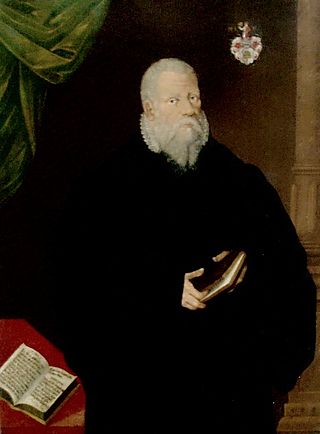
"Nun lasst uns Gott dem Herren" is a Lutheran hymn of 1575 with words by Ludwig Helmbold. It is a song of thanks, with the incipit: "Nun lasst uns Gott dem Herren Dank sagen und ihn ehren". The melody, Zahn No. 159, was published by Nikolaus Selnecker in 1587. The song appears in modern German hymnals, including in the Protestant Evangelisches Gesangbuch as EG 320.

"Ach lieben Christen seid getrost" is a Lutheran hymn in German with lyrics by Johannes Gigas, written in 1561. A penitential hymn, it was the basis for Bach's chorale cantata Ach, lieben Christen, seid getrost, BWV 114.

"Die güldne Sonne voll Freud und Wonne" is a Lutheran hymn by Paul Gerhardt. It is a morning hymn which was first published in 1666, with a four-part setting by Johann Georg Ebeling. Gerhardt created an unusual hymn metre for its 12 stanzas.

"Macht hoch die Tür" is a popular German Advent hymn, written in 17th century Ducal Prussia. The lyrics were written by Georg Weissel in 1623 for the inauguration of the Altroßgärter Kirche in Königsberg. The melody that is now associated with the text appeared first in 1704 in the hymnal by Johann Anastasius Freylinghausen.

"Zu Bethlehem geboren" is a German Christmas carol. The text is attributed to Friedrich Spee and was first printed in the collection Geistlichen Psälterlein by Johannes Heringsdorf in Cologne in 1637. The author was unknown until the 20th century, but research of style and content arrived at the attribution. The song was printed with a then-popular secular melody in 1638. The song appears in current Catholic and Protestant hymnals.

"Christ fuhr gen Himmel" is a German Ascension hymn. The church song is based the medieval melody of the Easter hymn "Christ ist erstanden". It was an ecumenical song from the beginning, with the first stanza published in 1480, then included in a Lutheran hymnal in 1545, and expanded by the Catholic Johannes Leisentritt in 1567. It appears in modern German Catholic and Protestant hymnals, and has inspired musical settings by composers from the 16th to the 21st century.

"Nun lasst uns gehn und treten" is a Lutheran hymn for New Year's Day by Paul Gerhardt. It appeared first in 1653 in Praxis Pietatis Melica. It is sung to the melody of "Nun laßt uns Gott dem Herren".

"Ist das der Leib, Herr Jesu Christ" is Catholic Easter hymn in German. The text was written by Friedrich Spee, first published in 1623. The song is still part of hymnals.
















